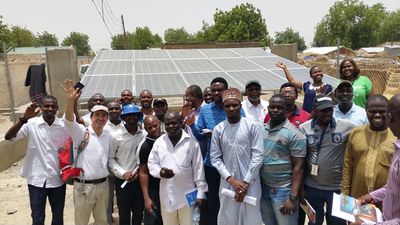Capacity Building and Learning on Solar Powered Water Systems
|
Webinar Series: Capacity Building and Learning on Solar Powered Water Systems |

Oxfam and IOM with funds from USAID’s Bureau of Humanitarian Assistance is implementing the Global Solar and Water Initiative (GLOSWI) project whose overall objective is to improve cost efficiency, reliability and sustainability of water access for displaced populations and affected host communities by effectively mainstreaming the use of solar water pumping technologies. One of the key objectives of this initiative is to strengthen knowledge on solar water pumping solutions among humanitarian WASH actors and develop capacity building options and technical support, with a focus on hard-to-reach places and first phase humanitarian emergencies. This will ensure emergency WASH actors have access to training opportunities and relevant information/materials and technical support.
Thus, this four-part webinar series, organized jointly by GLOSWI and energypedia will focus on solar powered water systems (SPWS) to raise awareness and to build technical capacity of humanitarian WASH actors as well as other development organizations.
Webinar I
Solar Powered Water Systems in Humanitarian Context – Types and Configurations
Wednesday, 25 Nov at 11:00 am CET (check your local time)
Register: https://register.gotowebinar.com/register/3282500016318418960
With falling panel costs and improvement in technologies, solar powered water systems (SPWS) have become a cost-effective and sustainable way of providing water in long-term displacement settings such as IDP camps as well as in host communities. This webinar, the first of the four-part webinar series, will introduce the SPWS technology focusing on different configurations such as DC vs AC, standalone vs hybrid, and submersible vs surface pumping. Lorentz and Grundfos will highlight their SPWS solutions available in the market as well as their applicability in the humanitarian context. A case study will then showcase SPWS examples from around the world.
Webinar II
Making Sense of Solar Powered Water Systems Expansion
January 2021
This webinar will discuss topics such as retrofitting solar into existing water schemes, over-pumping of acquirers and life cycle cost analysis of solar pumping schemes.
Webinar III
Towards more sustainable and efficient Solar Powered Water Systems
March 2021
This webinar will highlight the design aspects of SPWS along with the practical limitations. It will include topics such as batteries, tank sizing, hot water pumping and an example of SPWS planning for humanitarian settings.
Webinar IV
Towards more sustainable and efficient Solar Powered Water Systems
March 2021
This webinar looks into the efficiency of water pumping systems and how to operate and maintain SPWS for long-term sustainability. Topics include remote monitoring, choosing quality components, O&M concepts, and loss estimations among others.
<headertabs></headertabs>
Further Resources on Solar Powered Water Systems
Global Solar and Water Initiative (GLOSWI) Solar Pumping Resources
- Global Solar and Water Initiative (2018). Global Solar and Water Initiative. “Summary of findings” video file.
- Global Solar and Water Initiative (2018). “Solar Water Pumping Miniguide.
- Global Solar and Water Initiative (2018). Country Briefing Case study of Bidibidi Refugee Settlement, Uganda.
- EED Advisory Ltd. (2018). “Evaluation of the sustainability of solar powered water supply systems in Kenya.” EED Advisory Ltd. Nairobi, KE.
- Global Solar and Water Initiative (2018).Emergency Solar Pumping Kits. Global Solar and Water Initiative.
- Global Solar and Water Initiative (2018). Cost analysis Generator vs Hybrid, Cost analysis Generator vs Solar, Technical Briefing - Cost Analysis.
- Global Solar and Water Initiative (2018). “Criteria for Selection of Quality Solar Pumping Products & Services” and “Solar pumping bidding template”.
- Global Solar and Water Initiative (2018). “Physical Installation checklist” and “Operation & Maintenance kit”.
GLOSWI visit reports
- Global Solar and Water Initiative (2016). “Visit Report to Assess Feasibility for Solarisation of Existing Water Points in Asosa and Shire Refugee Camps in Ethiopia, 14 th to 21 st December 2016.”
- Global Solar and Water Initiative (2017). “Visit Report – Refugee and IDP Camps in Maban, Yida and Bentiu – South Sudan, 3 rd to 20 th July 2017.”
- Global Solar and Water Initiative (2017). “Visit Report – Solar and Water Initiative IDP settlements in Darfur, Sudan – 20 th February to 18 th March 2017.”
- Global Solar and Water Initiative (2017). “Visit Report – Solar and Water Initiative. Refugee settlements in Northern Uganda. 10th January to 6th February 2017.”
- Global Solar and Water Initiative (2017). “Visit Report to Borno State Nigeria, 12th – 19th June 2017.”
- Global Solar and Water Initiative (2019). “Visit Report to Somalia Region Ethiopia, 17th Feb to 2nd Mar 2019.
- Global Solar and Water Initiative (2019). “Visit Report to Borno State Nigeria, 6th to 19th April 2019.”
- Global Solar and Water Initiative (2019). “Visit Report to Northern Kenya, 23rd to 26th April 2019."
- Global Solar and Water Initiative (2019). “Visit Report to Kurdistan Region of Iraq, 27th July to 10th August 2019.”
Other resources
- World Bank (2016). “Solar Pumping: A Cheaper and Cleaner Way to Access Groundwater.” World Bank, Washington, DC. Video file.
- World Bank (2018). “Solar Pumping: The Basics.” World Bank, Washington, DC.
- Practica Foundation (2018). “Solar Pumping for Village Water Supply Systems.” Practica Foundation.
- Bamford, E. and Zadi, D. (2016). “Scaling up solar powered water supply systems: a review of experiences.” UNICCEF, New York, NY.
- Allouhi, A. et al. (2019). PV water pumping systems for domestic uses in remote areas: Sizing process, simulation and economic evaluation.
- Global Sustainable Energy Solutions (2019). “Solar Water Pumping Systems: System Design, Selection and Installation Guidelines.” Pacific Power Association and Sustainable Energy Industry Association of the Pacific Islands.
- Practical Action (2020). Solar Pumping for Water Supply: Harnessing solar power in humanitarian and development context
Organizers




















